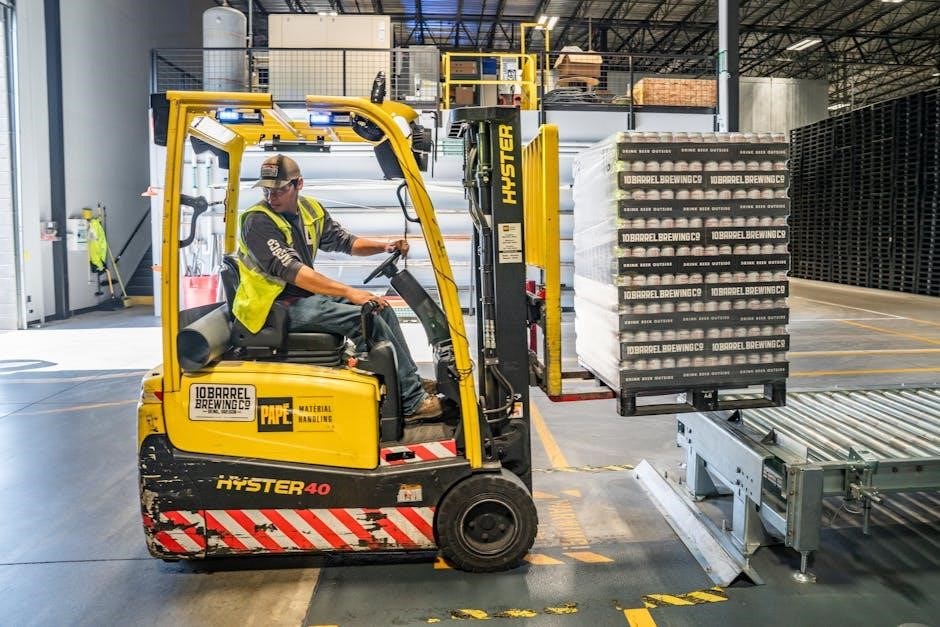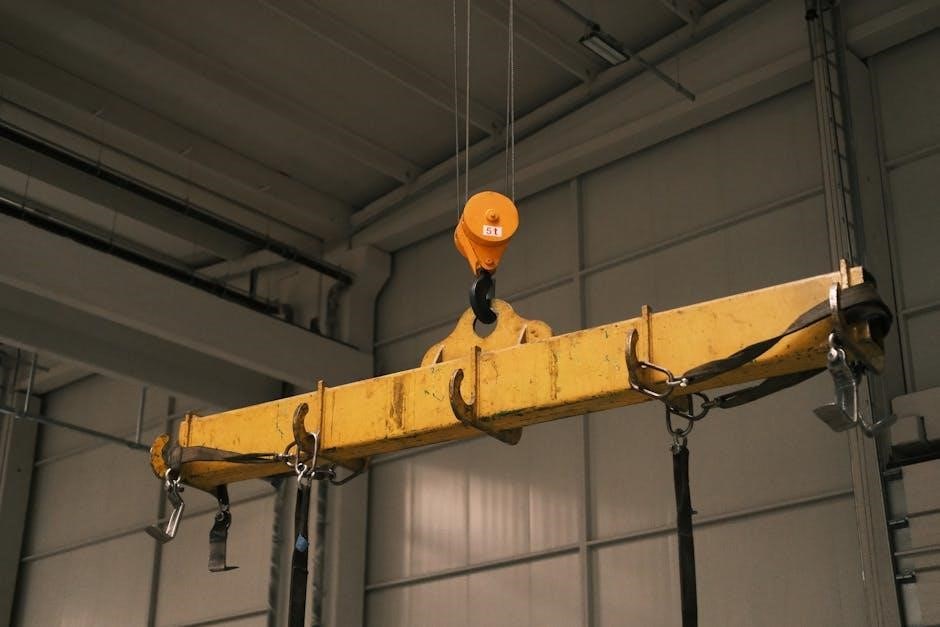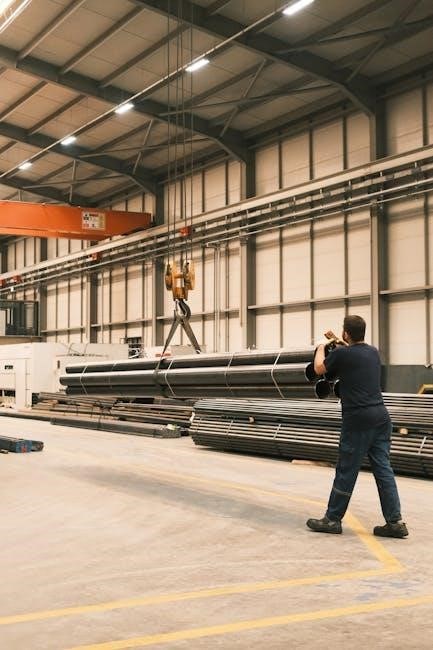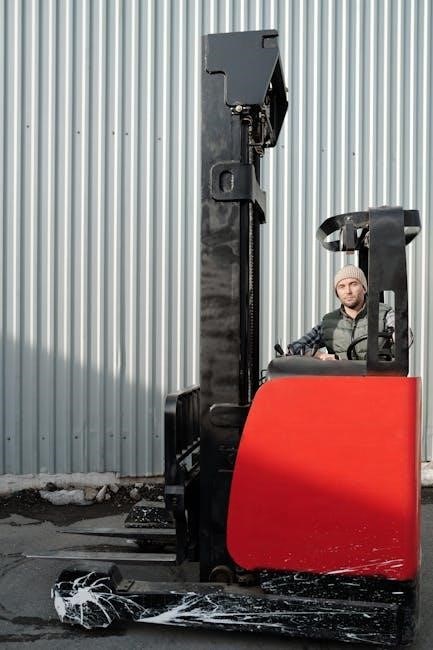Yale Forklift Owners Manual: A Comprehensive Guide
Welcome! This guide provides essential information for Yale forklift owners. It includes operation, maintenance, and safety. Explore high-quality maintenance and service resources to ensure efficient operations.
Yale forklift manuals provide crucial information for operating and maintaining your equipment. These manuals offer essential details, covering safety protocols, operational instructions, and maintenance schedules. They are designed to help owners and operators understand their Yale forklifts thoroughly, ensuring safe and efficient operation. The manuals contain important safety information, including warnings and notes, highlighted with specific symbols.
Using these manuals helps prevent accidents and prolongs the life of your forklift. You’ll find sections on troubleshooting, parts identification, and recommended service procedures. Whether you’re a seasoned operator or new to Yale forklifts, these manuals are invaluable resources. They guide you through pre-operation checks and safe operating procedures. Always refer to the appropriate manual for your specific Yale forklift model to get the most accurate information. These manuals contain descriptions and procedures to maintain the frame assembly for various lift truck models.

Understanding Your Yale Forklift Model
Identifying your Yale forklift model is crucial for accessing the correct manual and parts. This ensures accurate maintenance, safe operation, and effective troubleshooting. Find your model number easily.
Identifying Your Specific Model Number
Locating your Yale forklift’s model number is the first step in ensuring you have the correct information for maintenance, repairs, and operation. The model number is typically found on a data plate affixed to the forklift’s frame. This plate usually includes other important details, such as the serial number and manufacturing date;

Common locations for the data plate are the dashboard area, the side of the frame near the operator’s seat, or within the engine compartment. Once you find the data plate, identify the section labeled “Model Number” or “Model.” This alphanumeric code is unique to your specific forklift model and will help you access the correct manuals, parts catalogs, and service information.
Having the correct model number is critical for ordering replacement parts and understanding specific operating procedures, contributing to the safety and longevity of your Yale forklift.

Operation and Safety Instructions
This section details crucial guidelines for safe forklift operation; Review pre-operation checklists and understand safe operating procedures. Always prioritize safety to prevent accidents and ensure efficient workflows.

Pre-Operation Checklist
Before operating any Yale forklift, a thorough pre-operation checklist is essential to ensure safety and prevent equipment damage. Begin by inspecting the forklift for any visible damage, such as leaks, cracks, or loose parts. Check tire pressure and condition to ensure proper stability and handling. Verify that all fluid levels, including engine oil, coolant, hydraulic fluid, and brake fluid, are within the recommended ranges.
Inspect the forks for any signs of wear, bending, or damage, and ensure they are securely attached. Test the functionality of all safety devices, including seat belts, horns, lights, and backup alarms. Confirm that the battery is properly charged and connected for electric forklifts. Ensure the operating area is clear of obstructions, and adequate lighting is available.
Familiarize yourself with the forklift’s controls and instrumentation. Report any issues or discrepancies to the appropriate personnel before operating the equipment. This comprehensive checklist is critical for preventing accidents and maintaining optimal forklift performance.
Safe Operating Procedures
Adhering to safe operating procedures is paramount when using Yale forklifts. Always wear a seatbelt and any other required personal protective equipment. Before starting, ensure the load is within the forklift’s capacity and properly balanced on the forks. When lifting or transporting loads, keep them low to the ground to maintain stability. Avoid sudden stops, starts, or turns, which can cause the load to shift or the forklift to tip over.
Be mindful of pedestrians and other vehicles in the operating area, and use the horn to signal your presence. Never allow passengers to ride on the forklift unless it’s designed for that purpose. When operating on ramps or inclines, proceed slowly and cautiously. Ensure sufficient light source is allocated for work.

Regularly inspect the forklift for any issues and report them promptly. Never modify the forklift without authorization. By following these safe operating procedures, you can minimize the risk of accidents and injuries while maximizing productivity. Remember that Yale forklifts are not intended for use on public roads.

Maintenance and Repair
Maintaining your Yale forklift ensures longevity and safe operation. Regular maintenance and timely repairs are crucial. Consult your manual for schedules, troubleshooting, and part information.
Routine Maintenance Schedules
Adhering to routine maintenance schedules is paramount for the optimal performance and longevity of your Yale forklift. These schedules outline specific tasks to be performed at regular intervals, preventing potential issues and ensuring safe operation. Consult your Yale forklift owner’s manual for the precise maintenance schedule tailored to your specific model.
Daily checks should include inspecting fluid levels (oil, coolant, hydraulic fluid), tire pressure, and the functionality of lights and brakes. Weekly maintenance may involve lubricating moving parts, checking battery connections (for electric forklifts), and inspecting the forks for wear or damage.
Monthly or quarterly maintenance typically includes changing filters (air, fuel, hydraulic), inspecting hoses and belts for cracks or leaks, and conducting a more thorough examination of all systems. Annual maintenance should involve a comprehensive inspection by a qualified technician, including engine tuning, transmission servicing, and a complete safety check.
Regular adherence to these schedules, as detailed in your manual, will minimize downtime, reduce repair costs, and extend the life of your Yale forklift.
Troubleshooting Common Issues
When operating a Yale forklift, encountering occasional issues is inevitable. This section provides guidance on troubleshooting common problems, enabling you to diagnose and potentially resolve minor issues before they escalate. Always consult your Yale forklift owner’s manual for specific troubleshooting steps related to your model.
If the forklift fails to start, check the battery connections, fuel level, and ignition system. For hydraulic issues, inspect fluid levels, hoses, and cylinders for leaks or damage. Overheating can be caused by low coolant levels, a malfunctioning thermostat, or a clogged radiator.
Unusual noises, such as grinding or squealing, may indicate worn bearings, brakes, or other mechanical problems. Reduced lifting capacity could be due to low hydraulic pressure or a faulty pump. If the forklift is experiencing electrical problems, examine the wiring, fuses, and switches.
Remember, safety is paramount. If you are unable to resolve the issue or if it involves complex repairs, contact an authorized Yale service center for professional assistance. Proper troubleshooting, as outlined in the manual, can help you maintain safe and efficient forklift operation.

Parts and Service Resources
This section guides you to locate replacement parts and authorized Yale service centers. Explore options for genuine Yale parts and expert forklift maintenance. Ensure efficient repairs and maintenance.
Locating Replacement Parts
Finding the correct replacement parts for your Yale forklift is crucial for maintaining optimal performance and safety. Start by identifying your specific model number, as this will help narrow down the parts list in the manual. Refer to the parts manual for alternate pages and assembly details unique to your truck model code.
To find the desired part number, first determine the function and application of the part. Then, navigate to the relevant section in the parts manual. Identify the assembly the part belongs to within that section.
Yale offers high-quality maintenance parts to ensure your forklift operates efficiently. Consider exploring genuine Yale parts to guarantee compatibility and reliability. Upgrading with the correct parts ensures efficient repairs and maintenance.
If you’re unable to locate the part number in the manual, contact an authorized Yale dealer. They can provide assistance in identifying and sourcing the correct replacement parts for your specific forklift model.
Finding Authorized Yale Service Centers

Locating an authorized Yale service center is essential for professional maintenance and repairs of your forklift. These centers have certified technicians trained to work on Yale equipment, ensuring quality service.
To find a service center, start by contacting your local Yale forklift dealer. They can provide a list of authorized service centers in your area or direct you to the nearest one. You can also explore Yale’s official website for a directory of authorized service locations.

Authorized service centers offer a range of services, including routine maintenance, repairs, and inspections. They have access to genuine Yale parts and specialized tools, ensuring your forklift receives the correct components and service procedures.
Regular maintenance by authorized technicians can help prevent costly breakdowns and extend the lifespan of your forklift. Contacting a service center promptly for any issues ensures they’re addressed efficiently.